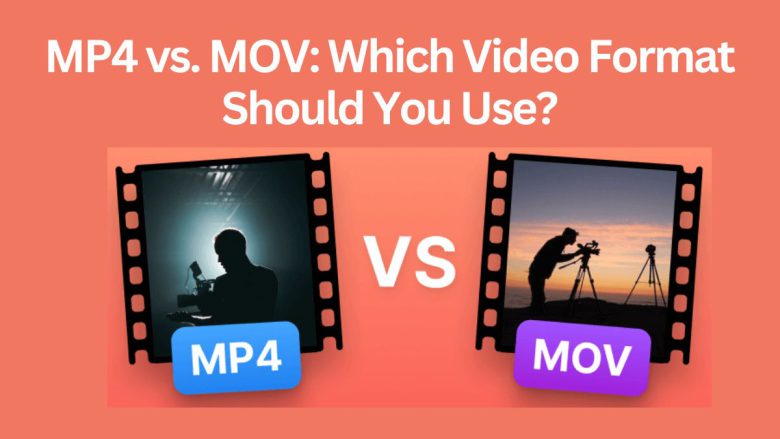
With many video formats, choosing the right one for your project can be a challenge. Among the most commonly used formats are MP4 and MOV. Both formats have pros and cons. It depends on their purpose and the platform you’re using. You must know the key differences between MP4 and MOV. It will help your video stream, edit, and play on some devices.
This post will explore the tech, benefits, and best uses of MP4 and MOV. It will help you choose the right video format.
What is MP4?
MP4, or MPEG-4 Part 14, is a digital format mainly used for video storage but can also store audio, subtitles, and images. It is a popular video format and is highly compatible across platforms and devices. MP4 files are often used for sharing videos on the web because they balance video quality and file size well.
Key Features of MP4:
- Compression: MP4 uses a compression algorithm that reduces file size while maintaining relatively good video quality, making it ideal for streaming and sharing online.
- Compatibility: MP4 is supported by nearly all media players, devices, and platforms, including Windows, macOS, Android, and iOS.
- Versatility: MP4 can store not only video and audio but also metadata, subtitles, and images, making it a highly versatile format.
What is MOV?
MOV is a video file format developed by Apple. It is mainly for the QuickTime media player. Like MP4, MOV can also store video, audio, and text (such as subtitles). MOV files have excellent video quality. But, they are larger than MP4s due to less aggressive compression. MOV is often preferred for video editing and archiving. It has a higher video quality.
Key Features of MOV:
- High-Quality Video: MOV is known for its ability to store high-quality video, which is especially important for editing and professional use.
- Apple Ecosystem: MOV is natively supported on Apple devices and software like iMovie and Final Cut Pro, making it a popular format among Mac users.
- Less Compression: MOV files are generally larger because they use less compression, which results in higher video fidelity compared to MP4.
MP4 vs. MOV: Key Differences
Now that we’ve covered the basics, let’s compare MP4 and MOV. This will help you find the right format for your needs.
1. Compression and File Size
- MP4: MP4 uses more aggressive compression than MOV, which significantly reduces file size without sacrificing too much quality. This makes MP4 ideal for online streaming, sharing, and storage when space is a concern.
- MOV: MOV files are typically larger because they use less compression, resulting in higher-quality video. However, the larger file size can be a drawback if you need to save space or share files quickly over the internet.
Which is better? If you need a smaller file size for easier sharing and streaming, MP4 is the better choice. For the best video quality, especially for editing, use MOV.
2. Compatibility
- MP4: One of MP4’s biggest strengths is its compatibility with a wide range of devices and platforms. Almost all media players and operating systems can play MP4 files, including Windows, macOS, Android, and iOS.
- MOV: MOV files are mainly associated with Apple’s QuickTime player and are optimized for Apple devices. MOV files can play on Windows and other non-Apple devices. But, they often need third-party software or codecs.
Which is better? MP4 is the clear winner when it comes to compatibility. If you need to share your video on different platforms, use MP4. It will let more people view it without extra software.
3. Video Quality
- MP4: MP4 uses efficient compression that balances video quality with file size. MP4 can keep high video quality. But, it doesn’t match MOV in fidelity, especially for professional use.
- MOV: MOV files offer superior video quality because they use less compression. They are ideal for video editing, archiving, and quality-focused work.
Which is better? For the best video quality, especially for editing, use MOV. However, for most everyday uses, MP4 provides sufficient quality with smaller file sizes.
4. Editing and Post-Production
- MP4: While MP4 files can be edited, they are not the first choice for professional editing because of the compression algorithms that can result in some loss of quality during the editing process. MP4 is more suited for final distribution rather than editing.
- MOV: MOV files, on the other hand, are favored for video editing because they retain higher video quality due to less compression. They are also supported by editing software like Final Cut Pro and Adobe Premiere.
Which is better? For extensive editing or post-production work, use MOV. It has higher quality and better compatibility with professional editing tools.
5. Online Streaming
- MP4: MP4 is the most common format for online streaming platforms like YouTube, Vimeo, and Facebook. Its small file size and compression make it ideal for fast loading and streaming. It won’t compromise quality much.
- MOV: While MOV can also be streamed online, its larger file size and higher video quality make it less suited for quick loading times and lower bandwidth environments.
Which is better? MP4 is best for streaming. It has a smaller file size and is compatible with web platforms.
When to Use MP4
MP4 is the top format for many uses. It’s versatile, small, and works on all devices. Here are some scenarios where MP4 is the better choice:
- Sharing Videos Online: If you need to upload a video to social media platforms or websites, MP4 is ideal due to its small file size and fast loading times.
- Cross-Platform Use: MP4 ensures that your video can be viewed on nearly any device without the need for additional software.
- Streaming: If you plan to stream your video on platforms like YouTube or Vimeo, MP4 is the best choice for fast, smooth playback.
When to Use MOV
MOV is a better option when video quality is your top priority. It is best for editing, archiving, or projects needing high visual quality. Here’s when you might want to choose MOV:
- Video Editing: For high-quality video editing and post-production, MOV files offer better quality and are widely supported by professional software.
- Apple Ecosystem: If you are working within the Apple ecosystem, MOV is natively supported and works seamlessly with software like iMovie and Final Cut Pro.
- Archiving: When archiving video footage for future use, MOV files provide higher quality, which can be important for preserving content.
Converting Between MP4 and MOV
There are situations where you may need to convert between MP4 and MOV formats. For example, you may want to share a high-quality MOV file online. Or, you may need to convert an MP4 file to MOV for better editing.
You can use various free and paid tools to convert between these formats. These include FileProInfo’s MP4 to MOV Converter and jedok MOV to MP4 Converter. They offer fast, online conversions without sacrificing video quality.
Conclusion
In the debate of MP4 vs. MOV, the right choice depends on your specific needs. For a small file size, decent quality, and wide compatibility, use MP4. If you need high-quality video for editing, use MOV. It’s better for professional use.
Both formats have strengths and weaknesses. Knowing them will help you choose the right one for your project. If you need to stream or edit videos, choose between MP4 and MOV. It can greatly affect your workflow and the final quality.


